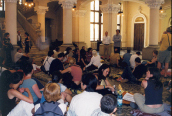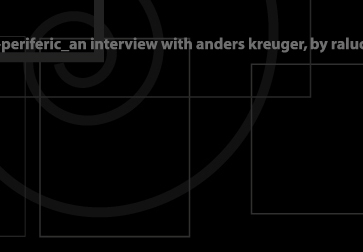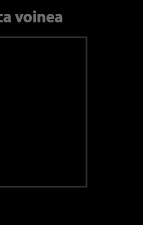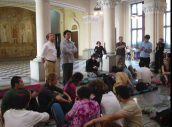Interview with Anders Kreuger, curator of the 6th Periferic Biennial, Iasi, Romania
(May 30 - June 14, 2003)
Catalin Gheorghe: As the invited curator of the "Periferic Biennial" you deviced a conceptual theme for the event ("Prophetic Corners") and then you made a heterogeneous selection of artists. Which were your criteria for this selection?
Anders Kreuger: First of all, I tried to
think of artists whose work would be relevant for an investigation of how
to "deal with the future": the future as a mental category of time,
imagined in close conjuction with the site as a mental category of space.
I wanted artists with an interest in thinking the future in non-utopian terms.
Artists are not academics, of course. You can't expect them to always comment
directly on the themes that you propose. That's not their job, really. Rather,
you can try to inspire them, suggesting a certain theme. This was my first
criterion: I looked for artists whose work and ideas would somehow fit into
the general theme of the exhibition.
My second criterion was that I wanted to invite people I already knew. Not
necessarily very well, and not necessarily on a very personal level, but of
whose personality I had some idea. I needed to work with people whom I could
trust. I needed to know that they would be interested in doing something here,
under sometimes difficult conditions. In fact, we had no institution and no
budget when we started. Also, Iasi is a city people don't know. Therefore,
they may be a little suspicious about coming here and doing work here. It's
easier to persuade people you already have a connection to.
The third important consideration in my selection of artists was also a pragmatic
one. I needed to know that we would be able to attract some funding with the
names i proposed for the exhibition. This is something you always do for projects
on this scale. One way of doing it is to involve a few artists who are well
known, in order to impress the people who could help you organize and fund
the event, and perhaps also the people who could write about it, people whom
you want to notice this event. In addition, you must make sure that you invite
artists from countries which are able and willing to pay for their participation.
All professionals know about these techiques for inviting artists to a large
group show, and no one is offended by them. This is the reality, a game you
have to play.
C G : You have seen the city of Iasi as a "well-kept secret", but how do you see it after the opening of the biennial?
A K: I don't think our opening changes much
for the image of the city, really. The image has to do with the way the city
functions. It's a university city where people lead rather comfortable lives.
This may sound a little cynical, coming from a foreigner who has seen many
more affluent or better organized places. But I've observed throughout Eastern
Europe that life there is actually quite comfortable. Of course people need
to have their own strategies for survival, their own security systems. Still,
lifestyles in the emerging economies and cultures of Eastern Europe, and in
cities like Iasi, are quite a bit more laid-back and relaxed than in a Western
metropolis.
One of the pluses of living in a place like Iasi is that you know your surroundings
and you're pretty safe with your own social networks. Even if you have to
make certain compromises or even sacrifices for survival, it's not like you
are always threaten by personal destruction or by fierce professional competition.
I think the more relaxed lifestyle will continue here. This will be a place
where people, in the end, will feel rather good about their lives. And perhaps
Iasi will continue to be somewhat invisible to the rest of the world…
C.G.: Do you think your "prophecy" for art - of thinking, creation, and integration - will be achieved here?
A.K.: A certain optimistic note underlines
the use of the concept of "the future" in a location like Iasi.
Talking about the future is a natural thing here, because the city is, on
the one hand, aware of and preparing for its role as a new outpost of the
European Union. The future of the city is a process of development which has
already started economically, socially and culturally. People seem quite confident
that this will continue.
But I'm not talking about the future in terms of prediction. I'm not trying
to figure out of what's going to happen on a concrete level in the city of
Iasi or in Romania. Rather, I'm trying to develop a notion of the future as
a natural category of time. Usually, we consider it impossible to think structurally
about the future just because we never have any information about it. That's
in our culture: we need information, verifications, data, we need technicalities
in order to deal with our lives. My "programme" for the exhibition
was to encourage creative thinking - about the future, about other things
- without this dependence on information and "hard" data.
C.G.: Do you think that the audience perceived the event this way? Can you tell me some of the reactions you received from the audience?
A.K.: I didn't get so much feed-back yet. I'm getting it now. Most of all from the curator students from the Royal College of Art in London who are now visiting Iasi. Their questions are to do mostly with how the exhibition spaces are used, how you can work with buildings that are this impressive in themselves, the Palace of Culture or the Turkish Bath. In which cases do the artworks just fill up the space? In which cases do they actually add something to the space or re-interpret it? I think that's an interesting discussion, even if it's a bit technical and narrowly "curatorial". Curating is a kind of spatial thinking. It's a lot to do with how you use space actively, as a category of thinking, and how you create a mental reality of the exhibition: through the works, through the writing, through the concept, but also in physical space.
C.G.: And what about the local audience?
A.K.: I think the people here they need a little time to articulate a reaction I notice that with my co-organizers and assistants. They need time to actually see the works, to think about them and to allow themselves to form their own opinion. They need to get past the phase of just being impressed by the fact that the work is shown here and that people have come from abroad to work in Iasi. The important think is to be able to experience the work on a personal level, and I think this is already happening. But people need a week or so to come back and see the works again and engage with them.
C.G.: About the continuation of this event, do you think that a biennial can develop with the infrastructure of a place like this, here, in Eastern Europe?
A.K.: Yes, but we have to remember that the
infrastructure is very different in different places in Eastern Europe. There
are huge differences between Lithuania and Romania, between Slovenia and Albania,
between Poland and Bulgaria. Eastern Europe is not a unified cultural space.
The experience people have had in these countries after the fall of communism
has been very different. Also under communism there were big differences.
In the specific field of activity which is mine - contemporary art curating
on a freelance basis and research about curating - there are very few places
in Eastern Europe that have a reputation for creative, innovative thinking
and activities. I believe Iasi is now one of them, particularly after we have
received quite a few people here from abroad. Not every country has a strong
contemporary art "scene". Not every capital has interesting institutions,
events or people.
Iasi is one of the rather the few places in this part of Europe where innovative
things are happening. People begin to be aware of this. Why is that? There
is one individual here, Matei Bejenaru, who has been a one-man institution
for years, and who has been doing the kind of work that normally is done by
the institutions in this field. He is realising his idea of developing a scene
here in Iasi. In other places in Eastern Europé the idea of something
interesting going on is based on what the institutions are doing. Vilnius,
Warsaw, Budapest, Ljubljana or Belgrade all have different kinds of art institutions,
from state financed official art spaces to independent or semi-independent
movements. They are all institutionalised to some degree. But the Iasi scene
is not. It's completely dependent on one person. And this makes it unique.
C.G.: What do you think must be emphasised for the next biennial? What do you think the organizers must change to make things better?
A.K.: It's not at all my competence or interest at this point to give directions for what the future event should be.
C.G.: You don't want to give advice…
A.K.: No, I don't want to do that in terms
of the content or curatorial set-up. I'm discussing this with Matei and perhaps
we will create a formalised platform for that kind of discussions. Perhaps
Matei wants to set up an advisory board, for example, and then I'll be more
than happy to contribute my advice and comments.
At this point, I'd only like to make a few logistical remarks, because I also
have been very heavily involved in the logistics of the event. The first priority
for next time is, I think, to make sure you have an operating budget before
you start working on the actual exhibition. You have two years to go, and
I'm sure that Matei will be able to get basic funding for the event during
the first year. Let's say up to 50 000 euro from some central foundations
or funding programmes just for setting up and running the institution. I say
institution, because the biennial is becoming an institution. It's important
for Matei to be able to offer an operating budget for the curator or the curators
he'll invite. I hope he'll no longer have to invite somebody to start from
zero.
For the future I think this is the most important thing to do, to institutionalise.
But this is also a problem, because if you institutionalise you also lose
some of the freshness and directness in the style in work that we have now.
But I know it's not possible to do this kind of work again, to pull off this
kind of enormously difficult and stressful work with only a handful of people
who aren't getting paid. The next edition of the biennial will be more structured,
I'm sure.
C.G.: What do you intend to do after this event, do you intend to do a major event like that in the nearest future?
A.K. No, I don't have anything planned on
this scale. And I think I wouldn't like to do a big event again directly after
this one. There are some disadvantages for a curator in working with a big
show. You're not able to get into a creative dialogue with each artist; you
are not able to involve yourself intellectually in the production of every
new work. You have to find a way of operating a big event which is a little
more institutional than creative, even if you're not backed up by an institution.
You need to think about all kinds of.personal politics, putting together a
show with this many people. You need to think about how to create a certain
volume or critical mass in order to attract attention to the event. You simply
need to fill up a certain amount of space with a certain amount of projects,
and sometimes, somewhere, in this process of filling up the framework that
you have decided, there is a risk that you lose some of the creative and critical
spirit you need to do a really good job as a curator. This is what the discussion
is about now when we evaluate the project. And the visit made by the British
curating students and their professors is very useful, because it helps me
to think through these implications.
My next project will be a much smaller one, in Amsterdam, next spring. The
working title is "The Violence of Tone", which sounds - and is -
a little bit cryptic. Several ideas come together in that project. One of
them is that the difference between disciplines in intellectual or artistic
life is not so much a difference in substance or in content as a difference
in tone. It's about how you talk about what you do, how you define yourself,
how you mark the boundaries, between independent curating and institutional
curating, between visual art and theatre, between art and science. Theses
boundaries are not motivated. They are creative, and the way you create them
is by tone. There is, I think, a certain violence in this way of defining
things. By selecting a certain tone you sort of de-select another tone, and
by talking to somebody in a certain tone you also violate that person, because
you define yourself and the other with the tone you chose.
Another idea is the idea of tone being intimately connected with emotion.
Tonality in language is usually seen as a system that operates on top of the
"hard" linguistic structures. On top of the phonetic, morphological
and syntactic construction of the sentence, you have the tonal curve, the
intonation, which is just as important for communication as the other three.
But it is often considered to be a kind of a last instance or even a decoration.
In fact, the tonality of communication - of language, and in this case of
art - is central to the understanding and articulation of our own emotions.
I'm going to focus on unarticulated emotions, on what can be called the small
emotions as opposed to the big ones. Not love and hate and envy, but rather
anticipation, disappointment, overestimation of your own possibility, embarrassment:
things that are not quite clear and thereby much more difficult to work out.
"The Violence of Tone" will be an exhibition in the centre of Amsterdam,
produced in collaboration with the art space W139, and it will be divided
between a flat and the street. There will be this element of outdoor/indoor
contrast, and there will also be a contrast between pictorial, image-based
work and performative work based on things happening in real time.
I'm preparing for this project by working for the theatre this summer, I'm
going to participate in a theater production at the Royal Dramatic Theatre
in Stockholm in August and September, a production of Sarah Kane, the English
playwrite who committed suicide some years ago, and whose plays are very brutal,
very raw, very physical. The production is by Oskaras Korsunovas, a young
and very successful director from Lithuania. I'm going to be the interpreter
between him and the Swedish actors.
C.G.: Is it something inspired by the "cruel theatre" of Artaud?
A.K.: Perhaps a little bit, but it's less literary than Artaud, less text-based. This is very physical theatre, and particularly the way it's going to be produced by this director. I usually have a problem with the theatre. I'm not a theatre person, so this is a little bit like a school for me: learning more about how theatre thinks. I hope I can use some of this thinking in my next project.
This interview first appeared in this summer's issue of ARThoc magazine.











